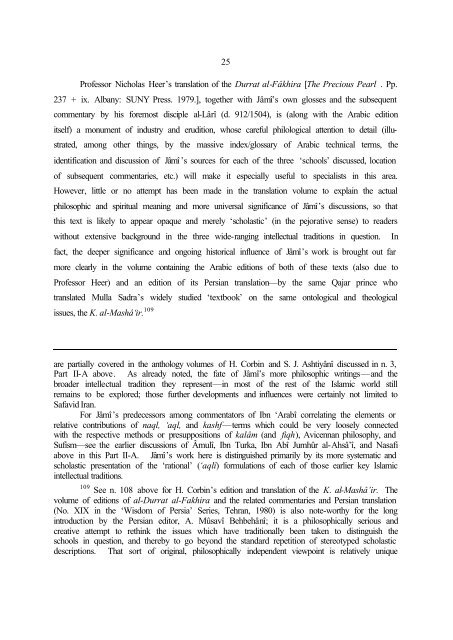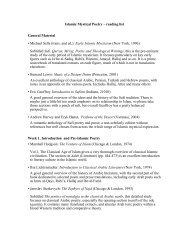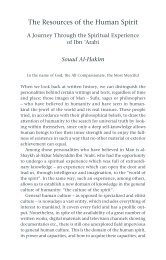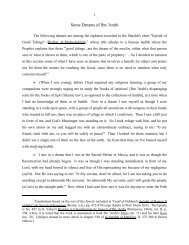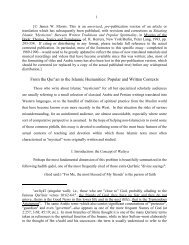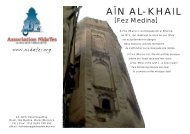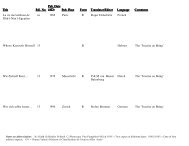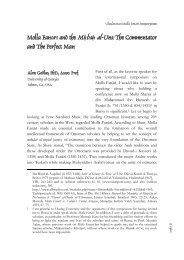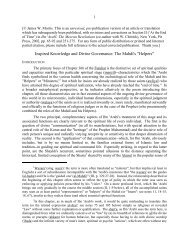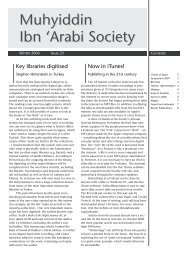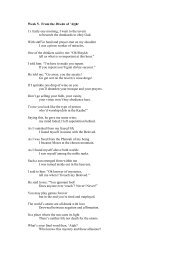Part III (pdf) - Muhyiddin Ibn Arabi Society
Part III (pdf) - Muhyiddin Ibn Arabi Society
Part III (pdf) - Muhyiddin Ibn Arabi Society
Create successful ePaper yourself
Turn your PDF publications into a flip-book with our unique Google optimized e-Paper software.
25Professor Nicholas Heer’s translation of the Durrat al-Fâkhira [The Precious Pearl . Pp.237 + ix. Albany: SUNY Press. 1979.], together with Jâmî’s own glosses and the subsequentcommentary by his foremost disciple al-Lârî (d. 912/1504), is (along with the <strong>Arabi</strong>c editionitself) a monument of industry and erudition, whose careful philological attention to detail (illustrated,among other things, by the massive index/glossary of <strong>Arabi</strong>c technical terms, theidentification and discussion of Jâmî ’s sources for each of the three ‘schools’ discussed, locationof subsequent commentaries, etc.) will make it especially useful to specialists in this area.However, little or no attempt has been made in the translation volume to explain the actualphilosophic and spiritual meaning and more universal significance of Jâmî’s discussions, so thatthis text is likely to appear opaque and merely ‘scholastic’ (in the pejorative sense) to readerswithout extensive background in the three wide-ranging intellectual traditions in question. Infact, the deeper significance and ongoing historical influence of Jâmî’s work is brought out farmore clearly in the volume containing the <strong>Arabi</strong>c editions of both of these texts (also due toProfessor Heer) and an edition of its Persian translation—by the same Qajar prince whotranslated Mulla Sadra’s widely studied ‘textbook’ on the same ontological and theologicalissues, the K. al-Mashâ‘ir. 109are partially covered in the anthology volumes of H. Corbin and S. J. Ashtiyânî discussed in n. 3,<strong>Part</strong> II-A above. As already noted, the fate of Jâmî’s more philosophic writings—and thebroader intellectual tradition they represent—in most of the rest of the Islamic world stillremains to be explored; those further developments and influences were certainly not limited toSafavid Iran.For Jâmî’s predecessors among commentators of <strong>Ibn</strong> ‘Arabî correlating the elements orrelative contributions of naql, ‘aql, and kashf—terms which could be very loosely connectedwith the respective methods or presuppositions of kalâm (and fiqh), Avicennan philosophy, andSufism—see the earlier discussions of Âmulî, <strong>Ibn</strong> Turka, <strong>Ibn</strong> Abî Jumhûr al-Ahsâ’î, and Nasafiabove in this <strong>Part</strong> II-A. Jâmî’s work here is distinguished primarily by its more systematic andscholastic presentation of the ‘rational’ (‘aqlî) formulations of each of those earlier key Islamicintellectual traditions.109 See n. 108 above for H. Corbin’s edition and translation of the K. al-Mashâ’ir. Thevolume of editions of al-Durrat al-Fakhira and the related commentaries and Persian translation(No. XIX in the ‘Wisdom of Persia’ Series, Tehran, 1980) is also note-worthy for the longintroduction by the Persian editor, A. Mûsavî Behbehânî; it is a philosophically serious andcreative attempt to rethink the issues which have traditionally been taken to distinguish theschools in question, and thereby to go beyond the standard repetition of stereotyped scholasticdescriptions. That sort of original, philosophically independent viewpoint is relatively unique


